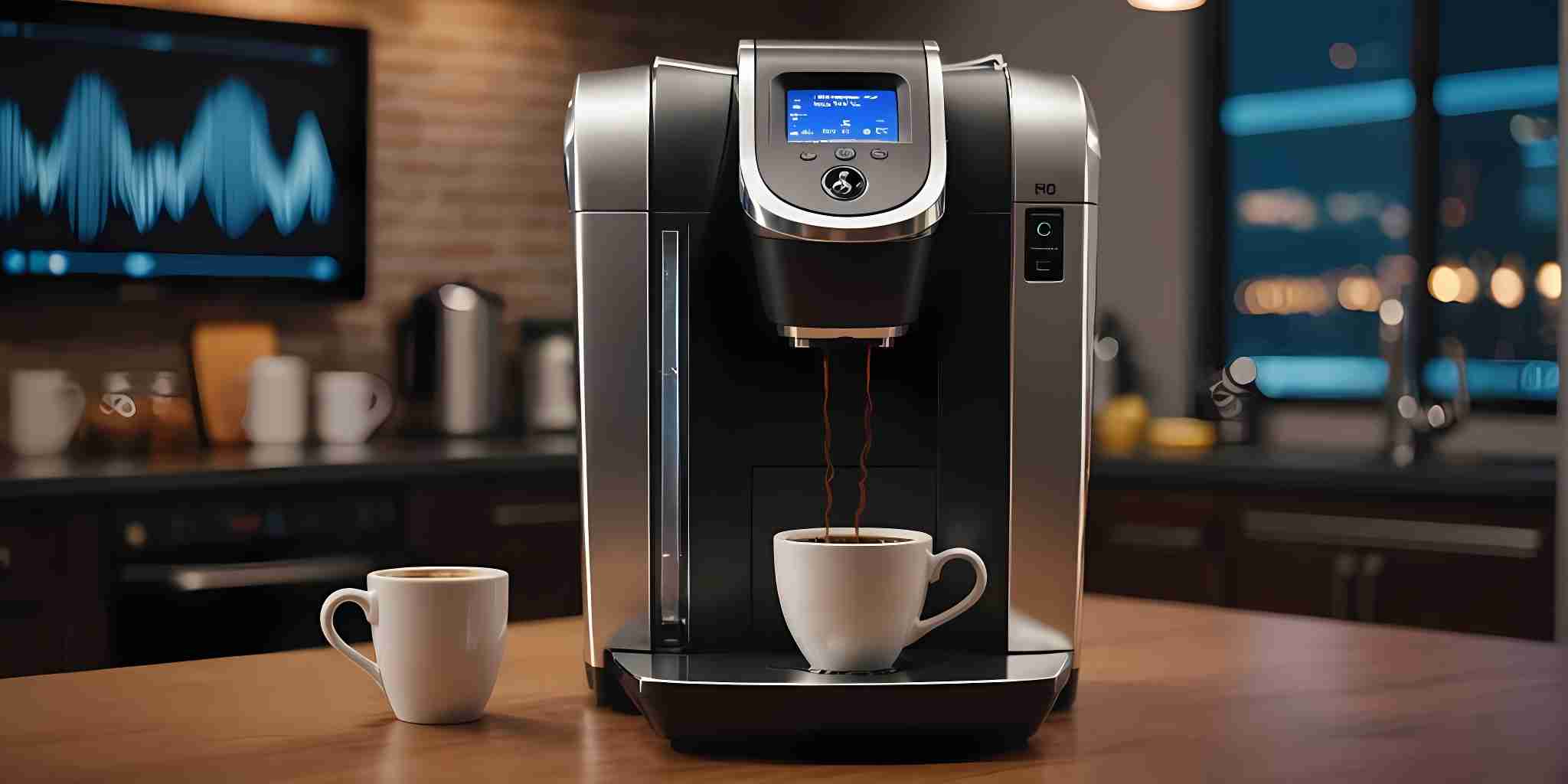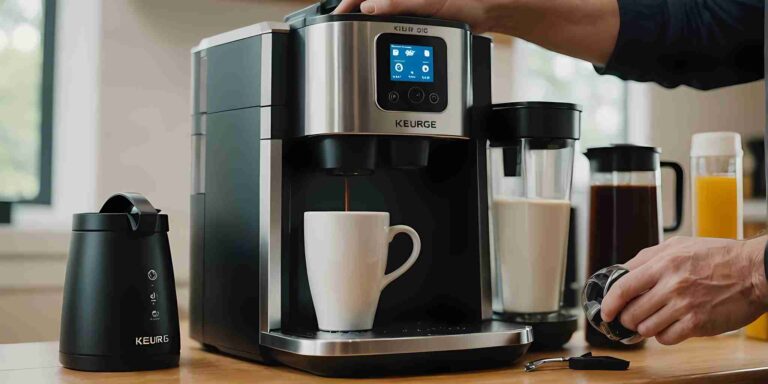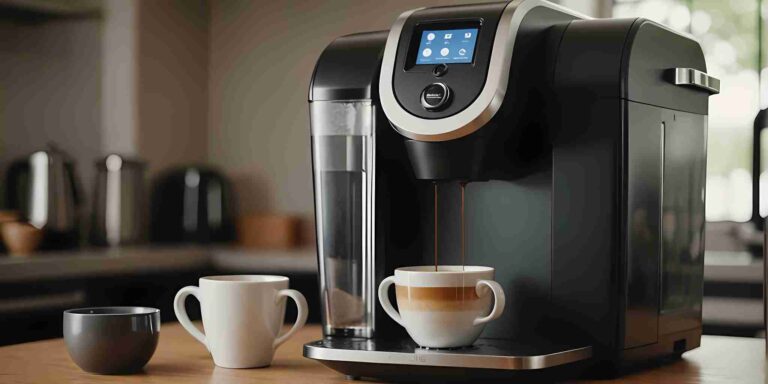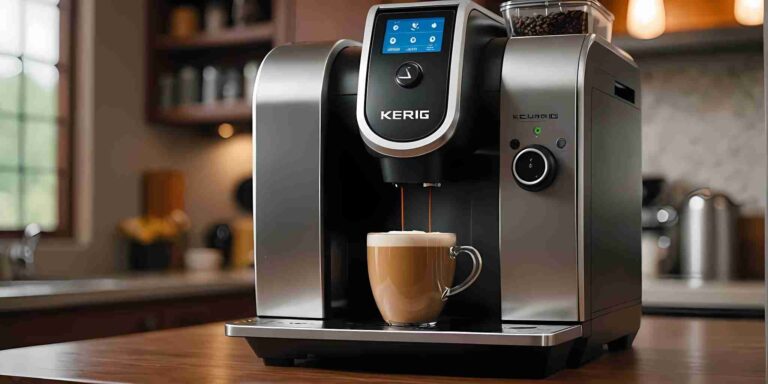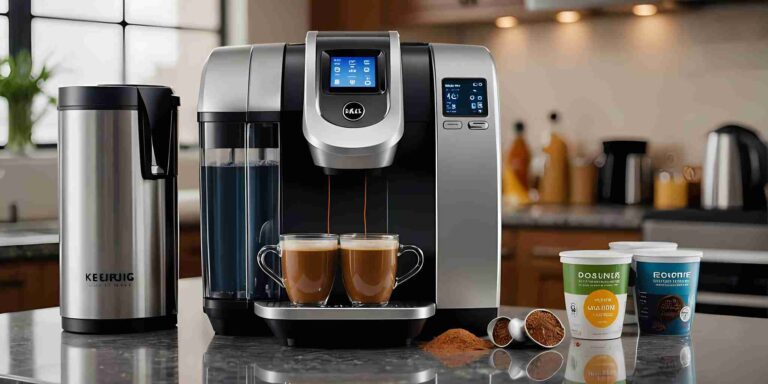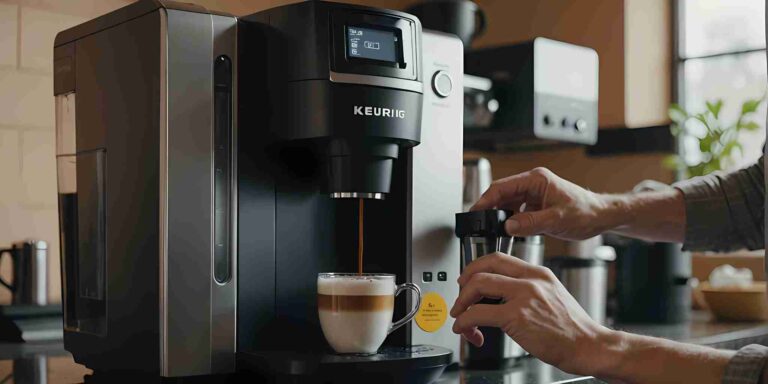Why Your Keurig Is So Loud: Common Causes and Solutions!
Ever wondered why your Keurig sounds like it’s brewing more than just coffee? Many Keurig users experience loud noises from their machines, which can be quite annoying.
This article explores common reasons for the noise and offers practical solutions to help you enjoy a quieter coffee-making experience.
Key Takeaways
- The water pump is often the main culprit behind the noise in Keurig machines.
- Mineral deposits can build up and cause the machine to be louder over time.
- Regular cleaning and maintenance are essential to keep your Keurig running quietly.
- Placing your Keurig on a soft surface can help reduce vibrations and noise.
- Loose parts inside the machine can also contribute to the noise and should be checked regularly.
Understanding the Noise Levels of Keurig Machines
Keurig machines are known for their convenience, but they can also be quite noisy. Understanding why your Keurig is loud can help you find ways to make it quieter. Let’s explore the factors that contribute to the noise levels of Keurig machines.
Factors Contributing to Noise
Several factors can make your Keurig noisy. The type of model you have plays a big role. Older models may lack quiet brew technology, making them louder.
Mineral deposits inside the machine can also cause clogs and affect water flow, leading to more noise. Regular maintenance is key to keeping your Keurig quiet.
Comparing Different Keurig Models
Not all Keurig machines are created equal when it comes to noise. For example, the K-Select was the quietest machine we recorded while it warmed up, edging out at 63 decibels, and finishing its brew at around 67 decibels. Newer models often have better noise-reducing features compared to older ones.
User Expectations vs. Reality
Many users expect their Keurig to be silent, but that’s not always the case. The reality is that some noise is normal, especially during the brewing process.
However, if your machine is excessively loud, it might be time to look into the specific causes and solutions.
Also Read: Keurig Descale Reset
The Role of the Water Pump in Keurig Noise
How the Water Pump Works
The water pump in your Keurig is essential for moving water from the reservoir to the internal tank. Without it, your coffee maker wouldn’t function.
The pump ensures that water flows smoothly through the machine, allowing for a quick and efficient brewing process.
Common Issues with Water Pumps
One of the most frequent problems is a faulty motor pump. When the coffee is finished brewing, it starts to make a noise like it’s having a pump issue for about 30 seconds. This unsettling noise often indicates that the pump is struggling.
Another common issue is air bubbles trapped in the pump, which can cause grinding noises and disrupt the brewing process.
Solutions for Water Pump Noise
To fix pump-related noises, start by checking if the water reservoir is properly aligned. If the problem persists, try descaling your machine to remove any mineral buildup.
For air bubbles, unplug the machine and gently shake it to release the trapped air. If these steps don’t work, you may need to replace the pump or consult Keurig customer service for further assistance.
Impact of Mineral Deposits on Keurig Noise
Mineral deposits can have a significant impact on the noise levels of your Keurig machine. Over time, minerals like calcium and salt can build up inside the machine, leading to various issues that can make your Keurig louder than usual.
Regular descaling and cleaning are crucial for preventing this buildup and ensuring your machine runs smoothly.
Identifying Mineral Buildup
One of the first signs of mineral buildup is a change in the taste of your coffee. If your coffee starts to taste bitter or off, it might be due to limescale and other mineral deposits.
Additionally, you might notice that your Keurig is taking longer to brew or is making unusual noises during operation.
Effects on Machine Performance
Mineral deposits can restrict water flow, causing your machine to work harder and become louder. This can also result in longer brewing times and inconsistent coffee temperatures.
Ignoring these signs can lead to more severe issues, such as damage to the water pump or other internal components.
Steps to Remove Mineral Deposits
To keep your Keurig running quietly and efficiently, it’s essential to remove mineral deposits regularly. Here are some steps you can follow:
- Descale your machine: Use a descaling solution specifically designed for coffee makers. This will help break down and remove the mineral buildup inside your Keurig.
- Run a cleaning cycle: After descaling, run a few cycles of plain water through the machine to rinse out any remaining solution and debris.
- Clean removable parts: Take out and clean the drip tray, pod holder, and any other removable parts to ensure there are no clogs or buildup.
By following these steps, you can maintain the performance of your Keurig and enjoy better-tasting coffee without the extra noise.
Also Read: Keurig Descale Light Won’t Turn Off
Importance of Regular Cleaning and Maintenance
Regular cleaning and maintenance of your Keurig machine are crucial for ensuring it runs smoothly and lasts longer.
Regular maintenance prevents clogs and ensures all parts of the machine function correctly. This extends the lifespan of your Keurig, providing you with many more cups of coffee.
Recommended Cleaning Schedule
To keep your Keurig in top shape, follow a consistent cleaning schedule:
- Daily: Wipe down the exterior with a damp cloth and remove any used coffee pods.
- Weekly: Clean the drip tray and water reservoir with warm, soapy water.
- Monthly: Perform a descaling cycle to remove mineral buildup.
- Quarterly: Deep clean the machine, including the needle and pod holder.
Tools and Products for Cleaning
Using the right tools and products can make cleaning your Keurig easier and more effective. Here are some recommended items:
- Microfiber cloths for wiping down surfaces.
- Soft brushes for scrubbing hard-to-reach areas.
- Descaling solution or white vinegar for removing mineral deposits.
- Mild dish soap for cleaning removable parts.
Benefits of Regular Maintenance
Regular maintenance offers several benefits:
- Improved performance: A clean machine brews coffee more efficiently.
- Better taste: Regular cleaning ensures your coffee tastes fresh and free of any old residue.
- Longer lifespan: Keeping your Keurig clean helps prevent wear and tear, extending its life.
- Healthier coffee: Regular cleaning prevents mold and bacteria buildup, ensuring your coffee is safe to drink.
Also Read: Keurig Add Water Light Not Working
Surface Placement and Its Effect on Noise
The surface your Keurig sits on can greatly affect the noise it makes. Placing your machine on a hard or uneven surface can cause vibrations and rattling sounds. A flat, stable surface is ideal for reducing noise levels.
Identifying and Fixing Loose Parts
Over time, your Keurig may start making more noise due to loose parts. This is often caused by the machine’s vibrations during use. If your Keurig keeps making noise, you might need to inspect and fix these parts.
Common Loose Components
Several parts of your Keurig can become loose, including:
- The water reservoir
- The drip tray
- The K-Cup holder
- Screws and bolts inside the machine
How to Secure Loose Parts
To fix loose parts, follow these steps:
- Unplug your Keurig and let it cool down.
- Inspect all detachable components, such as the water reservoir and drip tray.
- Tighten any loose screws or bolts you find inside the machine.
- Reassemble the machine and test it to see if the noise has reduced.
When to Seek Professional Help
If you can’t identify the loose part or the noise persists, it might be time to contact Keurig customer service or a licensed technician. They can help you troubleshoot and repair your machine effectively.
Addressing Design Flaws and Material Quality
When it comes to Keurig machines, design flaws and material quality can significantly impact your brewing experience.
Understanding these issues can help you make a more informed decision when purchasing or maintaining your coffee maker.
Optimizing the Use of Coffee Pods
Proper Insertion of Coffee Pods
Ensuring that your coffee pods are inserted correctly is crucial for optimal performance.
Misaligned pods can cause the machine to work harder, leading to increased noise and potential damage. Always check that the pod is seated properly before closing the lid.
Impact of Pod Quality on Noise
The quality of the coffee pods you use can significantly affect the noise level of your Keurig. High-quality pods are designed to fit perfectly and allow smooth water flow, reducing strain on the machine.
On the other hand, low-quality pods may not fit as well, causing the machine to make more noise as it struggles to brew your coffee.
Cleaning the Pod Area
Regularly cleaning the pod area is essential for maintaining your Keurig’s performance. Residual coffee grounds and oils can build up, leading to blockages and increased noise. Follow these steps to keep the pod area clean:
- Remove the used coffee pod immediately after brewing.
- Wipe down the pod holder with a damp cloth to remove any leftover grounds or liquid.
- Perform a quick inspection to ensure there are no blockages or buildup.
By keeping the pod area clean, you can ensure that your Keurig operates smoothly and quietly.
Advanced Troubleshooting Techniques
When your Keurig machine starts acting up, it can be frustrating. Here are some advanced troubleshooting techniques to help you get your machine back in working order.
Manual Reset Procedures
Sometimes, a simple reset can solve many issues. Unplug your Keurig, wait for about 30 seconds, and then plug it back in. This can help clear any minor glitches in the system.
When to Replace Parts
If your Keurig is still not working after a reset, it might be time to check for worn-out parts. Common parts that may need replacing include the water pump and the needle that punctures the K-Cup. Replacing these parts can often resolve persistent issues.
Consulting Customer Support
If all else fails, don’t hesitate to contact Keurig customer support. They can provide specific advice tailored to your model and may even offer replacement parts if your machine is under warranty.
Remember, the Keurig K-Café Barista Bar is a complex machine, and sometimes professional help is the best option.
Also Read: Keurig Not Working After Cleaning with Vinegar
Health and Safety Considerations
Risks of a Dirty Machine
A dirty Keurig machine can pose several health risks. Mold and bacteria can grow in the water reservoir and other parts of the machine if not cleaned regularly. This can lead to unpleasant tastes and potential health issues.
Preventing Mold and Bacteria
To prevent mold and bacteria, it’s important to clean your Keurig regularly. Use a mixture of water and vinegar to clean the water reservoir and run a brewing cycle without a coffee pod. This helps to remove any buildup and keep your machine safe to use.
Safe Cleaning Practices
When cleaning your Keurig, always unplug the machine first to avoid any electrical hazards. Use mild cleaning agents and avoid harsh chemicals. Regular cleaning not only ensures a safe machine but also extends its lifespan.
Evaluating the Lifespan of Your Keurig
Signs Your Keurig Needs Replacement
Your Keurig can last up to a decade with proper care, but there are signs it might be time for a new one.
If your machine is making unusual noises, brewing weak coffee, or taking longer than usual to brew, it might be nearing the end of its lifespan.
Frequent breakdowns and the need for constant repairs are also indicators that it might be time to replace your Keurig.
Extending the Lifespan of Your Machine
To get the most out of your Keurig, regular maintenance is key. Clean the machine regularly, descale it every 3-6 months, and use filtered water to prevent mineral buildup.
By following these steps, you can ensure your Keurig serves you well for many years. Remember, proper care can significantly extend the life of your coffee maker.
Cost-Benefit Analysis of Replacement
When deciding whether to replace your Keurig, consider the cost of a new machine versus the cost of repairs.
If repairs are becoming frequent and costly, it might be more economical to invest in a new Keurig.
Additionally, newer models often come with improved features and better energy efficiency, which can save you money in the long run.
Also Read: Keurig Not Pumping Water
Conclusion
In summary, a noisy Keurig can often be traced back to a few common issues like mineral buildup, loose parts, or an uneven surface. Regular cleaning and descaling are key to keeping your machine running smoothly and quietly.
By taking the time to maintain your Keurig, you can enjoy a peaceful coffee-making experience and extend the life of your machine.
If problems persist, don’t hesitate to reach out to Keurig’s customer service for further assistance.
Keeping your Keurig in top shape ensures that your morning coffee ritual remains a delightful and noise-free part of your day.
Frequently Asked Questions
How often should I descale my Keurig?
You should descale your Keurig every three months to keep it running smoothly and quietly.
Can I use vinegar to clean my Keurig?
Yes, you can use a mix of one part vinegar and one part water to descale your Keurig.
What should I do if my Keurig is making loud noises?
If your Keurig is loud, try descaling it first. If that doesn’t help, check for loose parts or contact Keurig support.
Why is my Keurig brewing different amounts of coffee each time?
Inconsistent coffee amounts can be due to clogs or other issues. Cleaning the machine and descaling it can help.
Is it important to clean the area where the coffee pods go?
Yes, keeping the pod area clean helps your Keurig function better and reduces noise.
Why does my Keurig feel cheaply made?
Some Keurig models use thinner plastics, which can make them feel less sturdy.
How can I reduce the noise my Keurig makes?
Place your Keurig on a soft, stable surface and make sure all parts are tightly secured.
When should I consider replacing my Keurig?
If your Keurig is old, frequently noisy, or not working well even after cleaning, it might be time for a new one.
Also Read:

